"We Are Being Invaded With Lies and Propaganda"
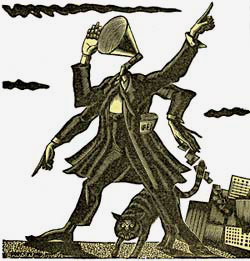 A drawing portrays the destructive nature of the rumormonger. (Folder 48, Box 25, Defense Council Records, OSA)
A drawing portrays the destructive nature of the rumormonger. (Folder 48, Box 25, Defense Council Records, OSA)
Federal officials knew
they had to control messages during the war to keep morale high on the home front. They did this in a number of ways, such as establishing guidelines for "voluntary" media censorship and influencing the content of Hollywood films. The government also produced its own films, radio broadcasts, pamphlets, posters
and
propaganda in an effort to portray the nation and its war efforts as favorably as possible. Along with getting the
message out, federal officials also sought to squelch "an
amazing new anti-war 'rumor factory'" run by the Axis nations that aimed to flood the United States with "enormous lies founded on half-truths." Oregon officials followed suit by founding the Rumor and Propaganda Division of the Oregon State Defense Council, designed to hunt down rumors and kill them dead with facts.
Footnote 1
National Propaganda and Rumor Control Efforts
President Roosevelt wanted to avoid the excesses of the
Committee on Public Information,
formed during World War I to control
public opinion through propaganda.
Its efforts fueled the passions
of Americans, both good and bad.
To be sure, the committee reminded
the nation that it was fighting for democracy and freedom. And its propaganda helped sell war bonds and promote positive actions such as reducing absenteeism in factories. But its releases also raised hysteria and led to repression and violence by portraying Germans as Huns, evil creatures perpetrating atrocities as
part of their greedy aim to conquer the
world. The committee hinted that
German spies were hiding around every corner;
that any work stoppages were tantamount
to treason; that any dissent was unpatriotic;
and that socialists and pacifists were secretly sympathizing with the enemy.
Footnote 2
Instead,
during World War II, the
federal Office of War Information
(OWI) took the lead in
shaping and disseminating
approved information with
a more subtle approach. The OWI worked
with Hollywood studios to release movies that
showed people working together for a successful outcome,
both on the battlefield and in home front efforts.
While the studios agreed with
this approach, they also knew the government could
withhold their licenses to export films. Government officials
also withheld and released photographs depending on their predicted effect on home front morale. Thus, photographs of dead Americans and other graphic subjects were deemed to be too damaging for morale and not released until 1943. With Allied war successes, OWI officials switched positions and released the graphic photographs in a bid to reduce overconfidence and keep home front war efforts high.
Footnote 3
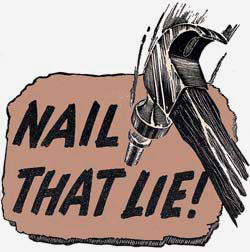 Nailing or spiking a rumor meant to not repeat it and to tell the rumormonger to stop spreading it too. (Folder 16, Box 35, Defense Council Records, OSA)
Nailing or spiking a rumor meant to not repeat it and to tell the rumormonger to stop spreading it too. (Folder 16, Box 35, Defense Council Records, OSA)
The OWI also tracked and investigated alleged instances of German and Japanese propaganda efforts in the United States. One rumor that officials considered particularly heinous concerned a Minnesota mother who purportedly "received by parcel post from Japan a box containing the eyes of her soldier son captured in the Philippines." OWI officials investigated and said that "no such mother could be found and none of the rumor peddlers knew where the story started." However, officials "learned the 'fear rumor' had been beamed to South America by Radio Tokio and passed along by Axis agents...." They also combated other rumors around the country. For instance, someone in North Carolina said that "Atlantic Coast beaches were closed to swimmers because so many of them bumped into bodies of drowned American soldiers." Other rumors, such as one from New York, sought to weaken the country through prejudice: "Jewish boys get doctors to pep up their heart beats to dodge the draft." The OWI claimed to "trace most of this stuff to 'Radio Station Debunk,' a powerful Berlin shortwave outfit purporting to exist somewhere in the American Midwest as a United States station 'telling the truth' about the war."
Footnote 4
Oregon Forms its Own Rumor Clinic
Oregon officials formally got into the rumor control
business in September 1942 with the formation of the Rumor and
Propaganda Division of the Oregon State Defense
Council. Work began under
the direction of prominent
Portland attorney, David Robinson,
who was "formerly national chairman of the
German Boycott League, and as such,
familiar with propaganda methods of Germany."
A committee, which oversaw the work of the division, included
members from the Oregon Mental Hygiene Society,
The Oregonian and
Oregon Journal newspapers, and radio stations KGW-KEX and KOIN-KALE as well as a noted psychiatrist and a Reed College professor.
The division established contacts with federal agencies but noted that "neither the FBI nor Military Intelligence would in any way officially be connected with the Rumor and Propaganda Division." By October, the division
set up shop in Portland with a "full-time secretary" and a "mainline telephone," ready to take calls from concerned citizens and meet the challenge of rumors head on.
Footnote 5
The division needed to develop a strategy and publicize its efforts to Oregonians. For publicity, it relied on newspapers, radio programs, and advertisements to spread a message centered on the concept that "we are being invaded with lies and propaganda." The division claimed that:
The strategy aimed to convince Oregonians to take three steps when confronted with a rumor: First, they needed to "spot" the rumor by determining if it casted suspicion on U.S. allies, discredited the government or leaders, fomented hatred and suspicion against racial or religious groups, or more generally hurt morale. Second, they needed to "spike" the rumor by making sure it stopped with them: "Don't repeat it to a soul - not even at home!" Spiking also included asking the person for the source of the rumor and telling the person to stop spreading it. Third, they needed to "report" the rumor by immediately contacting the Rumor and Propaganda Division with the pertinent information. The division then pledged to thoroughly investigate the rumor, publish the "true facts," and pass along relevant information to the FBI.
Footnote 7
Shipyard Rumors
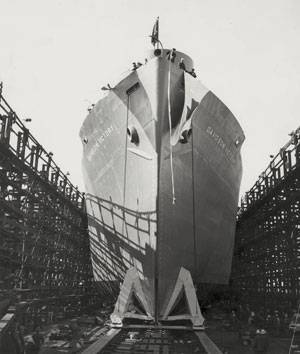 The SS Davidson Victory,
launched by the Oregon Shipbuilding Corporation in Portland in 1945, was one of many Victory ships built in area shipyards, which were
natural sites for rumors. (Image courtesy Wikimedia)
The SS Davidson Victory,
launched by the Oregon Shipbuilding Corporation in Portland in 1945, was one of many Victory ships built in area shipyards, which were
natural sites for rumors. (Image courtesy Wikimedia)
Once
telephone calls and letters began to arrive, patterns of rumors became clear. Not surprisingly, many rumors centered on activities at the shipyards in the Portland area. Rumor #19 claimed that "the Sheriff's office was informed that a bulkhead at the Oregon Shipbuilding corporation over turned several nights ago killing 17 people. That great numbers of men are being killed and that the news is being suppressed." Meanwhile, rumor #22 said "three women welders and eleven men were killed at the Oregon Shipbuilding corporation on or about September 30, 1942." The informant, L.F. Rose, "was indignant over the rumor and upheld the safety precautions of the Oregon Shipbuilding corporation." Other rumors about the shipyards claimed that "practically 95%" of the workers from other states were ex-convicts, many from New York. Rumor officials investigated and found that of the 2,500 workers from the New York area, "only one [was a] parolee and that this one man had not been guilty of any kind of heinous crime." Officials blamed enemy propaganda designed to "create friction between the new workers and other workers and the local populace thus retarding shipbuilding purposes."
Footnote 8
Salvage Drive Rumors
Many rumors targeted salvage efforts, making drives appear to be a waste of time. According to rumor #53, a wife accidentally gave her husband's golf clubs to a scrap metal drive and later found
they had been resold by Goodwill Industries. Goodwill denied obtaining items from scrap drives. Rumor officials said
if people believed that items given to scrap drives were then resold at stores, it would discourage them from donating scrap, thus slowing the war effort. Numerous rumors centered on salvaged scrap metal or household fats being buried or dumped. Rumor #165B claimed truck loads of tin cans were being hauled to the city dump. Officials tracked the problem to a garbageman, who may have been
either uninformed or simply lazy. They lamented that
"if this story is believed it will cause Portland men and women to figure - what's the use of going to the trouble of cleaning, pressing and saving tin cans when they are to be thrown away anyhow[?]" Rumor #259, spread by an Oregon State College student, claimed that "hundreds of thousands of pounds of grease and fats were buried in large pits around Camp Adair." State officials asked the college president to refute the rumor on campus to combat the impression
that "it is just a waste of time for housewives to save grease and fat." Meanwhile, rumor #287 said that salvaging household fats was only a ploy to "keep the housewife busy." It claimed that hotels and other businesses simply disposed of fats: "Union Pacific Railway just throws the fat along the tracks." An investigation found that "troop trains seem to have no containers in army kitchen cars for saving grease." After the rumor division wrote a letter of complaint to President Roosevelt, an Army representative replied that they had changed their operational instructions to require the use of grease containers.
Footnote 9
Enemy Attack Rumors
Numerous rumors claimed enemy attacks had occurred or were imminent. Some showed how nervous some people were after two real aerial bombings of Curry County forest land in September 1942, which resulted in little damage. Rumor #11 claimed that "Port Orford was wiped off the map night before last." Officials noted the date of the second bombing was correct but that it caused even less damage than the first bombing. Word leaked out about the bombings and the county saw reporters and photographers from
Life magazine, the Associated Press, state newspapers, and others but "it had become a closed military area and all these people were sworn to secrecy, and no information released so the Japs won't know the damage done." Rumor #85 upped the ante when a hitchhiking sailor claimed that a bomb containing "bubonic plague germs" was dropped on Curry County.
Rumor #285 in the summer of 1943 claimed the
Japanese had established a landing on the
Oregon coast south of Bandon. It said that
"a number of landing barges from several troop transports off the coast" placed enemy soldiers in a position to take over two Coast Guard stations. The rumor also claimed a Japanese soldier was shot south of Roseburg on Highway 99 and that three bridges near Coos Bay were blown up. An investigation concluded "the rumor that 'something' happened is still very persistent around Roseburg, and felling [feeling] against the authorities is running quite high over the fact that the truth has not been released."
Footnote 10
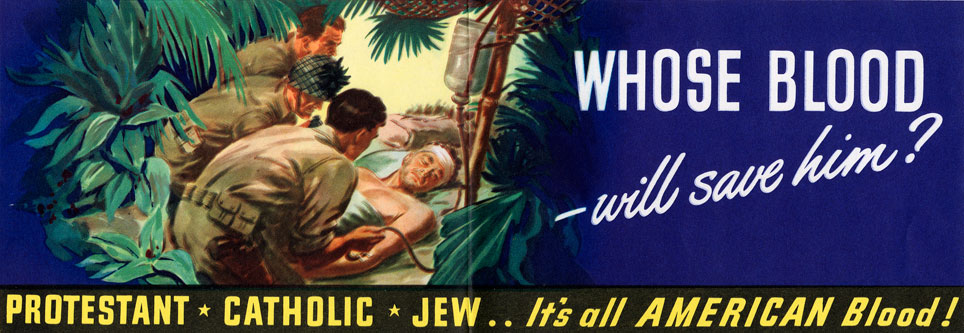 According to officials, any talk that divided America by race, ethnic group, or religion helped the Axis strategy. (Oversize Records, Defense Council Records, OSA)
According to officials, any talk that divided America by race, ethnic group, or religion helped the Axis strategy. (Oversize Records, Defense Council Records, OSA)
Rumors Against African Americans
Rumors against African Americans betrayed
underlying racism in Oregon. Rumor #58 stated
that defense housing units on McLoughlin
Blvd. near Portland were to be "occupied by negroes." The rumor claimed "all property owners in the nearby vicinity are up in arms." A check with the Clackamas County housing authority found that out of 600 housing applications, none were from African Americans. Many rumors claimed
African Americans posed a physical threat to white people. One rumor, #137, claimed that "all negroes who are brought to Portland carry knives presumably of a forbidden type and for unlawful purposes." This was refuted by John Keegan, captain of detectives for the Portland Police Bureau, who said
"'this is a damn lie.'" Keegan added
"we have had very little trouble with the colored workers who were brought in. Only two colored boys gave us any grief and
they are in custody and being tried." Rumor # 297 in October 1944
claimed a riot between "Whites and Negroes" erupted in Vanport and had "assumed serious proportion." A call to the Vanport school superintendent found
that the incident "had been exaggerated beyond all semblance of truth." Apparently, it was simply a school ground fight between a white boy and an African American boy with classmates standing around watching. Still, the rumor escalated to include an "assault on a pregnant white woman by negroes."
Footnote 11
Rumors Against Jewish People
Many rumors resulted
from discrimination and stereotypes
against Jewish people.
Some flatly advocated violence, such as the Wolf Creek
man who allegedly stated "that we should kill off all the Jews." This prompted a letter from the rumor division to the FBI, which responded
with a letter saying the matter would "receive attention." Some rumors implied Jewish men were shirking military duty. Rumor #135 asked if it were true "that the Jews are not enlisting in the armed forces of the United States?" A woman apparently heard the rumor from men in her family who worked at the shipyards where "a lot of this kind of talk was done while the men were riding in the trucks back and forth to work." By far the most rumors centered on the stereotype that "the Jews control all the wealth of the world" and exploited their power for selfish reasons. Rumor #141, circulating in the Bend area, claimed that "this rubber business makes me tired, the Jews are just making a big profit out of it and the scrap drive." The manager of radio station KBND in Bend told state officials about the rumor and remarked that: "many of these, of course, are more the grumblings of thoughtless people, than rumors of malicious intent; nevertheless, I think they should be nailed as false. They certainly don't aid in building morale."
Footnote 12
Rumors Against People of Japanese Descent
People of Japanese descent also drew
rumors, many related to their lives in the internment camps.
Rumor #33 claimed that "the Japs are getting $50 a month plus board and room in the Internment Camps." When rumor division officials could not immediately provide an answer, two Portland women were "quite indignant," saying
"they wanted to know whether such an amount was paid the Japs when so many of our old folks could only get twenty or thirty dollars a month pension." A call to the U.S. Employment Service established that the top pay, even for doctors and other professionals, was only $16 per month, exclusive of room and board.
Footnote 13
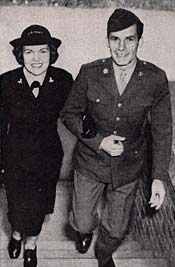 Recruitment literature promoted the social benefits of joining: "Certainly WAVES can have dates--with officers, enlisted men or civilians! This pretty WAVE is stepping out for an evening's fun with a friend." (Folder 2, Box 35, Defense Council Records, OSA)
Recruitment literature promoted the social benefits of joining: "Certainly WAVES can have dates--with officers, enlisted men or civilians! This pretty WAVE is stepping out for an evening's fun with a friend." (Folder 2, Box 35, Defense Council Records, OSA)
Along the same lines, rumor #95 said
"first grade hams and meats are being furnished to the Jap Camp near Klamath Falls [Tule Lake] when it is almost impossible for American citizens to get this same grade of meat." Officials couldn't give
a precise answer to this rumor but
noted it had been "reported that dealers in Klamath Falls when asked for ham say that it is all going to Jap camps." One
theory held that a "crooked deal" had been
made with high prices charged but lesser quality meat delivered. A variation of the rumor claimed
bacon and ham were scarce because so much of it was sent to Tule Lake. Rumor #127 distilled the antipathy down to one sentence: "It's a G____D____ outrage to place American citizens on short rations and at the same time permit those yellow B_________ to enjoy ease and plenty at our expense."
Footnote 14
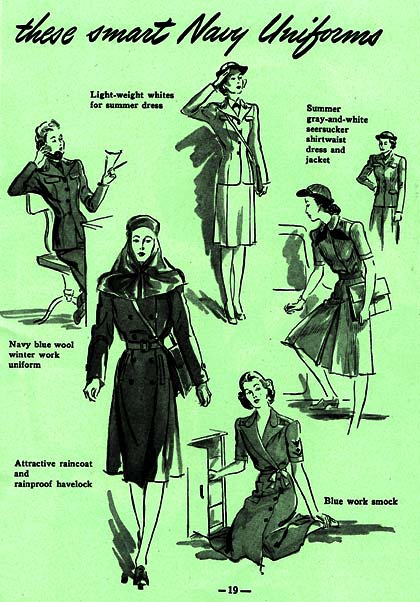 Rumor #72 implied the
stylish uniforms offered to recruits in the WAVES made them a bit too attractive to Army officers. (Folder 2, Box 35, Defense Council Records, OSA)
Enlarge image
Rumor #72 implied the
stylish uniforms offered to recruits in the WAVES made them a bit too attractive to Army officers. (Folder 2, Box 35, Defense Council Records, OSA)
Enlarge image
One rumor focused on the condition in which Japanese Americans left their farms when forced to relocate. Rumor #100 stated that "the ground of Japanese farms out toward Oregon City has been poisoned by Japanese evacuees before they left so that any thing planted there would be just too bad for the persons eating it." Officials noted that the purpose of the rumor was to frighten people "thus lowering morale" and referred to a professor who said that "scientifically it is absurd. Any poison of the character described would probably destroy all plant life."
Footnote 15
Other Rumors
The Rumor and Propaganda Division collected many more rumors throughout the rest of the war. A number of them reflected a suspicion that unfair practices were at work in
rationing. Others claimed war bonds would be worthless. Still others claimed
massive waste and fraud within the Red Cross while some looked for shadowy conspiracies in the corporate ranks. Rumor #72 stated that "the WAVES [a Navy women's service] are considered by the Army officers as their property and they can do as they please [with them.]" Officials concluded the purpose of the rumor was to "make relatives of both men and women in the service unhappy and apprehensive, thus lowering morale." Rumor #21 put forth another strange claim, saying that "in most Nursery Schools the children are doped to keep them quiet." The Portland woman who told of the rumor was worried because she had been offered a good job and needed to put her four-year-old son in day care. He had overheard her talking about the doping and cried: "I don't want to go to school and be shot in the arm." The state health board investigated and found no facts to support the rumor but did admit to allowing seven unlicensed day care centers to continue to operate because "all the day nurseries were full and their [sic] wouldn't be any place for the children to go."
Footnote 16
 Billboards reminded Americans they were fighting for freedom of religion. Disparaging talk and rumors hurt the cause. (Oversize Records, Defense Council Records, OSA)
Billboards reminded Americans they were fighting for freedom of religion. Disparaging talk and rumors hurt the cause. (Oversize Records, Defense Council Records, OSA)
Related Document
Rumor Book (Report #s 1-30), Rumor and Propaganda Division, Oregon State Defense Council, 1942-1945. Folder 48, Box 25, Defense Council Records, OSA.
Notes